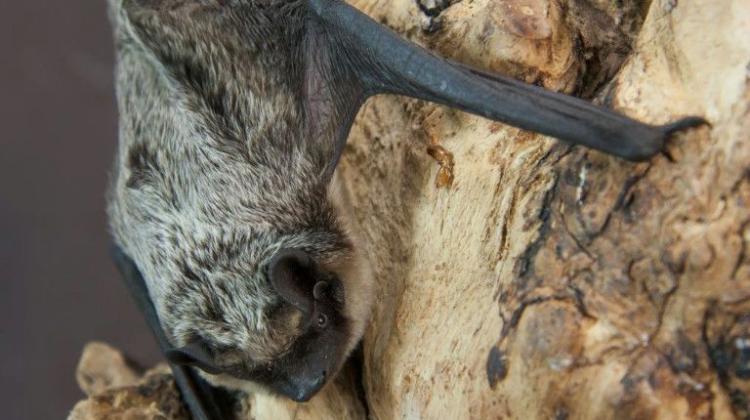Silesian Foothills: bat paradise
 Photo: Fotolia
Photo: Fotolia
Silesian Foothills are home to 20 out of 25 species of bats found in Poland according to a 22 years long study. It is a bat paradise, mainly due to the variety of habitats, commented Dr. Robert Mysłajek from the University of Warsaw.
The species found in the region include the lesser horseshoe bat, Bechstein\'s bat, Geoffroy\'s bat, lesser noctule and Northern bat, classified as endangered or vulnerable species in Poland. "It’s a real bat paradise here! As many as 20 species of fauna, which in Poland has 25 species, of which four are the species observed sporadically in Poland. Here we have almost the full set" - said Dr. Mysłajek from the Institute of Genetics and Biotechnology, Faculty of Biology, University of Warsaw, one of the authors of the publication "Protecting our Mother Nature," which presents the results of monitoring.
"Bats are thermophilic, and therefore there are more species in the south than, for example, near Warsaw. Silesian Foothills are home to numerous breeding colonies of southern thermophilic species - the lesser horseshoe bat. It is a relatively rare bat in Poland, it is found only in the Carpathians, Sudetes and Krakow-Czestochowa Jura. The productive colonies are, however, considerable, some count approx. 300 animals"- said Dr. Mysłajek.
Species found in Silesian Foothills represent two families: the majority (19 species) are vesper bats, one - a horseshoe bat.
The study also allowed to locate the most important positions of these nocturnal mammals. In particular, the lesser horseshoe bat positions are numerous. The most valuable breeding colonies are in the church in Jaworze, in the castle in Grodziec, in school and preschool complex in Grodziec and in the church in the Górki Wielkie.
Carpathian part of the Silesian province is still poorly explored in terms of nature. "Especially the Foothills are very interesting in this respect, because on the one hand, there are species that come down from the mountains, on the other those that come from lowland areas. It is a mosaic of habitats typical for both the mountains and lowlands" - he explained.
Dr. Mysłajek added that Silesian Foothills are the most densely populated part of the Carpathians. "We have a huge number of people, up to 300 per 1 km2, while the Polish average is 127. We were interested in the bat species composition and whether it the presence of people is beneficial or an obstacle" - he said.
Data on bats had been collected for 22 years (since 1992). "It\'s one of the few projects with such a wide time range. The earliest data come mainly from monitoring of hiding places and reports of people. Since 2000 we have conducted strict fauna research, very extensive, using different methods, for example chiropterological networks and ultrasonic detectors" - emphasised Dr. Mysłajek.
Bat catching was carried out in 23 locations during 38 nights. Researchers captured bats from 16 species, of which the most numerous were Daubenton\'s bats (32.7 percent) Brandt’s bats (22.4 percent) and whiskered bats (13.8 percent). They also recorded the echolocation of bats. It is this method allowed to track soprano pipistrelle.
Dr. Mysłajek noted that only two professional scientists were involved in the collection of data: monitoring of bat hiding places (mainly cellars and attics) and interventions concerning animals accidentally discovered in buildings; others were members of the amateur movement and NGOs - Association for Nature "Wolf" (Stowarzyszenie dla Natury "Wilk") and Association "Hills Nature Club" (Stowarzyszenie "Górecki Klub Przyrodniczy"), and even employees of the Municipal Office in Cieszyn. "Scientists conduct research and publish, but NGO members and employees of local government agencies can use research results in practice, for example to apply for the establishment of protected areas or to educate" - said Dr. Mysłajek.
Due to the richness of species, study authors propose to cover the most valuable bat positions with protection. "We propose various paths of action. It\'s not just Natura 2000 sites, but also local forms of protection established by municipalities and communes, such as documentation sites and natural landscapes. Very interesting species of bats live in existing nature and landscape complexes in Silesian Foothills, an example is Bucze Mountain, located in the village of Górki Wielkie"- said the biologist.
Attitude of people towards bats is sometimes unfriendly, so effective protection can not be achieved without education. "We benefit in several ways from the presence of bats. It is a direct profit, because bats eat insects that bother us every day. Their presence also means tangible benefits for agriculture and forestry, because in the forests they catch species of insects harmful from the point of view of forestry, for example moths" - explained Dr. Mysłajek.
In most European countries, particularly in the EU member states, all species of bats are under strict protection.
PAP - Science in Poland, Anna Ślązak
zan/ mrt/
tr. RL
Przed dodaniem komentarza prosimy o zapoznanie z Regulaminem forum serwisu Nauka w Polsce.


















